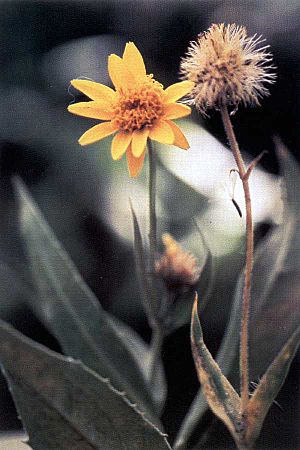Clasping arnica facts for kids
Arnica lanceolata is a cool plant from North America. People often call it the clasping arnica or lanceleaf arnica. It's part of the sunflower family, just like the big sunflowers you might know! This plant is special because it grows in two main areas that are far apart in North America.
Quick facts for kids Clasping arnica |
|
|---|---|
 |
|
| Arnica lanceolata subsp. prima California |
|
| Scientific classification | |
| Genus: |
Arnica
|
| Species: |
lanceolata
|
| Synonyms | |
|
|
Contents
About the Clasping Arnica
The clasping arnica is a perennial herb. This means it's a plant that lives for many years, coming back each growing season. It usually grows from a small underground stem called a rhizome. This rhizome helps the plant spread and store energy for future growth.
What the Clasping Arnica Looks Like
The plant produces one or more stems that can be a bit hairy and sometimes sticky. These stems are lined with about 5 to 10 pairs of leaves. The leaves are oval-shaped and can grow up to 12 centimeters long. They also have a slightly toothed edge.
When it blooms, the clasping arnica has clusters of several daisy-like flower heads. These aren't just one big flower, but many tiny flowers grouped together! In the center, you'll see brownish disc florets. Around the edge, there's a fringe of bright yellow ray florets. These ray florets look like petals and are about 1 to 2 centimeters long.
After the flowers bloom, the plant produces a small, dry fruit. This fruit is shaped like a cylinder and is covered in tiny hairs. It also has a light brown, fluffy top called a pappus. This pappus helps the seeds float away in the wind, spreading the plant to new places.
Where the Clasping Arnica Grows
The clasping arnica has a "disjunct" distribution. This means it's found in separate areas that are not connected. You can find this plant in two main regions of North America.
Subspecies of Clasping Arnica
There are two main types, or subspecies, of Arnica lanceolata:
- Arnica lanceolata subsp. lanceolata : This subspecies grows in the northeastern parts of North America. You can find it in places like Quebec, New Brunswick, Maine, New Hampshire, Vermont, and New York.
- Arnica lanceolata subsp. prima : This subspecies is found in the western parts of North America. Its range includes Alaska, Yukon, Northwest Territories, Alberta, British Columbia, Washington, Oregon, California, Idaho, Montana, Utah, Wyoming, and Nevada.

